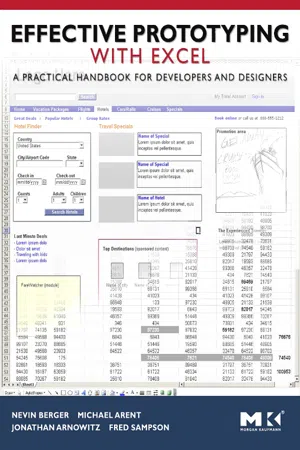
Effective Prototyping with Excel
A Practical Handbook for Developers and Designers
- 240 pages
- English
- ePUB (mobile friendly)
- Available on iOS & Android
Effective Prototyping with Excel
A Practical Handbook for Developers and Designers
About this book
Although recognized as a key to the design process, prototyping often falls victim to budget cuts, deadlines, or lack of access to sophisticated tools. This can lead to sloppy and ineffective prototypes or the abandonment of them altogether. Rather than lose this important step, people are turning to Microsoft Excel® to create effective, simple, and inexpensive prototypes. Conveniently, the software is available to nearly everyone, and most are proficient in its basic functionality.Effective Prototyping with Excel offers how-to guidance on how everyone can use basic Excel skills to create prototypes – ranging from narrative wire frames to hi-fidelity prototypes. A wide array of software design problems and business demands are solved via practical step-by-step examples and illustrations.- Step-by-step guide to prototyping with a simple and affordable tool nearly everyone already has on their desktop- Quickly and easily allows web and software designers to explore usability, design alternatives, and test theories prior to starting production- Perfect companion to Effective Prototyping for Software Makers – with the same author team and full-color treatment, useful case studies, and hands-on exercises
Frequently asked questions
- Essential is ideal for learners and professionals who enjoy exploring a wide range of subjects. Access the Essential Library with 800,000+ trusted titles and best-sellers across business, personal growth, and the humanities. Includes unlimited reading time and Standard Read Aloud voice.
- Complete: Perfect for advanced learners and researchers needing full, unrestricted access. Unlock 1.4M+ books across hundreds of subjects, including academic and specialized titles. The Complete Plan also includes advanced features like Premium Read Aloud and Research Assistant.
Please note we cannot support devices running on iOS 13 and Android 7 or earlier. Learn more about using the app.
Information
A Case Study
Introduction
Excel Prototyping
Prototyping Flexibility
Table of contents
- Cover image
- Table of Contents
- Copyright
- Dedications
- Acknowledgments
- About the Authors
- Chapter 1. A Developer's Dilemma
- Chapter 2. Getting Started
- Chapter 3. Basics
- Chapter 4. Creating an Excel Prototyping Template
- Chapter 5. Excel Prototyping
- Chapter 6. Wireframes
- Chapter 7. Digital Interactive Prototypes
- Chapter 8. Iterating Prototypes With Excel
- Chapter 9. Communicating Your Design in Excel
- Chapter 10. Sharing Your Excel Prototype
- Appendix A. Useful Techniques with Excel
- Appendix B. Nevin Discovers Excel as a Rapid Prototyping Tool
- Appendix C. Glossary
- Index